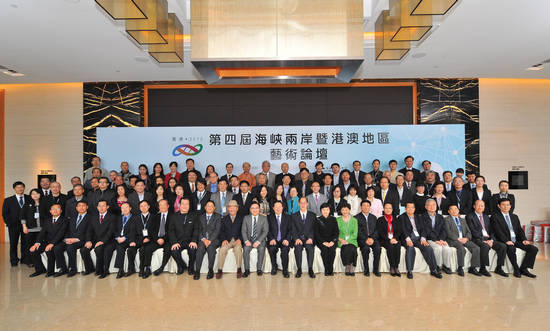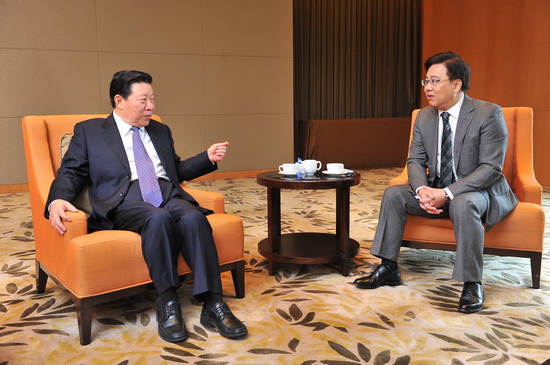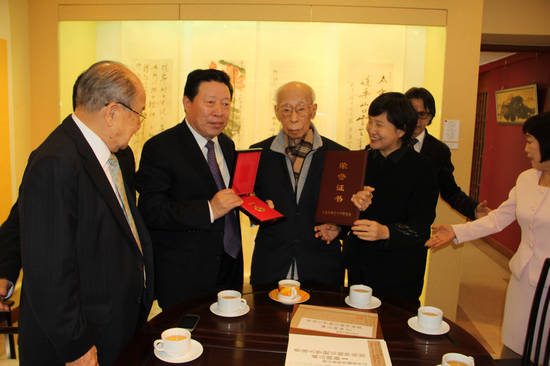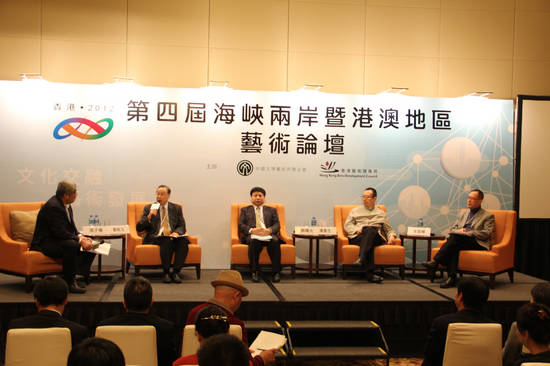Culture: Seemingly Delicate, Perseverant Indeed
——Sidelight of the 4th Chinese Art Forum of Mainland,
Hong Kong, Macao and Taiwan

Group Photo of Participants of the Forum

Sun Jiazheng Had a Talk with Wong Ying-wai, Chairman of Hong Kong Art Development Council, Prior to the Official Opening of the Forum

Sun Jiazheng Conferred Certificate and Golden Medal of Honorary Member of CFLAC to Jao Tsung-I

Roundtable Communication on Hong Kong
What will people from the mainland feel when they arrive at Hong Kong? On the 4th Chinese Art Forum, Lang Wei, president of Humanities College of Ningxia University told us his personal experiences. He was trapped in panic in his first trip to Austria, upon getting off the airplane. With few people at the airport and totally strange language and signs, he felt lonely and miserable. However, when he arrived at Hong Kong, he could recognize those traditional Chinese characters and felt internally cozy and confident, even in sleep. As to the reason, he held that he shared a lot in common with people in Hong Kong. The great distance and dialect barrier would not keep his Chinese heart from echoing with Chinese culture and arts here. Of course, this is commonly acknowledged by many artists and scholars from mainland, Taiwan, Macao and Hong Kong. Some of them participate in this forum for the first time, while some have become the constant guests of this forum. Thanks to this annual gathering, many participants have become old friends with each other.
“Culture, seemingly delicate, proves to be greatly perseverant. In history, when much ostentatious stuff disappears, only excellent cultures survive.” Such a wonderful speech by Mr. Sun Jiazheng at the opening ceremony aroused unanimous response and support from the artists and scholars present at this forum. In his opinion, the across-the-strait relationship has come into a new stage of extensive exchanges, cooperation and development. The communication frequency of personnel, the depth of projects' exchange and extension of cooperation fields have been unprecedentedly developed. A heart-to-heart communication is the very basis and prerequisite of exchange, cooperation and development, and nothing would be better than culture in fulfilling such communication. He expected all the participants to pour out their views freely concerning the current situation, better communications and friendship, and make their own contribution to the prosperity and development of Chinese culture and arts in the new century.
Madame Yang Chengzhi, vice president of CFLAC, addressed at the opening ceremony as well. She believed that this forum, ever since its birth, has obtained positive feedbacks and enormous support from mass writers and artists, gathered their wisdom and effectively promoted cooperation. With the increasing influence, this forum has gained more and more popularity in the art circles. Coinciding with the successful conclusion of the 18th National Congress of CPC, many key predications and planning put forward in this congress such as building cultural power, improving the whole nation’s cultural creativity, constructing heritage system of excellent cultures and promoting time-honored traditional Chinese culture will provide a guideline for us to fulfill the development of Chinese culture. We are now encouraged to continue increasing cultural exchange among four locations so as to strengthen national identity, compatriots’ feelings and realize common progress and reciprocity.
Under the theme of Cultural Integration and Art Development, experts from mainland, Hong Kong, Macao and Taiwan such as Dan Zeng, Chan Wing-wah, Kuo Meng-yung, So Shu Fai, YAU Foon-chi and Hu Kangmei delivered respectively themed speeches on the opening day of the forum—November 20 while Li Qiankuan presided over the meeting. In their speeches, they shared some views that ideas of building a cultural power and preserving peaceful development across the strait put forward in the 18th National Congress of CPC will inspire them to make joint efforts to publicize and showcase excellent Chinese culture and enhance its charisma and influence. During group discussions, the participants conducted extensive and profound view exchange concerning art promotion and education in the multi-element cultural circumstance, youth art talents training, art education and courtesy as well as common and local character of Chinese culture. It is the common aspiration to shoulder the historic responsibility to inherit, innovate and promote excellent Chinese culture in the international community.
Master Jao Tsung-I, honorary member of CFLAC and lord of Chinese culture studies, is a representative figure in cultural circle in Hong Kong. Engaged in academic research and teaching for more than seven decades, he has conducted extensive studies in the following 13 disciplines: paleography, oracle studies, epigraphy, historiography, etymology, history of religion, Chuci, Dunhuang studies, bibliography, Sino-foreign relationship, ancient Chinese literature and Chinese art history. So far he has fulfilled over 70 publications. After the opening ceremony, Sun Jiazheng, president of CFLAC, paid a special visit to Jao in his academy. At the sight of this hale and hearty elderly, Sun Jiazheng said in delight, “As a master of Chinese culture studies, you have made an outstanding achievement in academic research and art. Your health is indeed bliss for Hong Kong, and also for Chinese culture.” Then Sun Jiazheng conferred this senior citizen the certificate and gold medal of CFLAC Honorary Member, and inscribed the title for Jao’s academy. In return, Jao gifted his own calligraphy and paintings. Despite his age of 97, Jao still keeps practicing calligraphy and Yoga. He was so excited that he even waved his arms in the air resembling writing with brush when cross-legged on the stool. According to his assistants, Jao almost keeps such practice every day so that his fists are still powerful. When shaking hands with him in the greetings of the Spring Festival, even youngsters can hardly bear his force. Prior to bidding goodbye, Sun Jiazheng warmly invited win to visit Beijing and wished him good health, expecting his further contribution for Chinese culture development.
Within the four years, this forum has traveled from Hainan to Taiwan, then Macao and Hong Kong, so those four locations have gained experience of sponsoring such a significant event. On this starting point of a new round, we have retrospect for the past and perspective for the future. Obviously, the next session is already full of expectations.
Experts’Viewpoints
Power of Culture
DAN Zeng (Vice President of CFLAC)
Currently with the fading influence of faith, people are gaining more and more desire for material. Superficial luxury enjoyment and internal spiritual emptiness lead to expansion of selfish desire and excessive vanity. Officials ignore sense of shame, merchants give up honesty and the wealthy abandon justice. In order to strengthen the soft power of national culture, promote Chinese culture and build a cultural power, we need to seek a development mode and strategy that in line with historic trend, people’s will and works efficiently. It is also necessary for us to reflect over the overdue profanity in cultural development. In our opinion, profanity is an indispensible factor in the cultural development, but should not be too excessive. It is a must to preserve the solemn character of culture, persist in the mass recognition of cultural value and safeguard culture as a national spirit.
Importance of Continued Education of Culture and Arts
CHAN Wing-Wah (Vice President of Chinese University of Hong Kong and President of the Composers and Authors Society of Hong Kong)
Education of culture and arts will improve personal quality, broaden mind and vision, and enhance personal aesthetics. Knowledge of cultures both at home and abroad will enrich knowledge, foster observation and inspire imagination. Mutual appreciation in cultural exchange will avoid the conflict caused by misunderstanding and therefore promote harmony in the human society.
Within the current education system that attach importance to economic efficiency and skill training, education of culture and arts fails to occupy a proper proportion in the curriculum of primary schools, secondary schools and universities. Even those professionals upon graduation from the university have limited command of culture and arts, which hinders their own progress in career. In this case, culture and arts are a lifelong continued education for both full-time and the retired, helpful in spiritual abundance and complementary to campus education. With boundless connotations and excellent factors, Chinese culture has increasingly become a main source of reference in the international design, architecture, medicine, culture and philosophy. Many overseas scholars as well as other professionals such as architects and designers have gained a profound knowledge of Chinese culture. The self-awareness in culture and originality in arts make it more important to learn about the culture of motherland.
Cultural Industry and Art Development
Kuo Meng-Yung (Director General of Taipei Artists Cultural Educational Promotion Foundation)
As to the three concepts connected to each other, art, creativity and culture, we need to think about how to make proper adjustment and integration in management strategy and art industry upgrade so as to realize the special spirit and value of cultural creative industry. In this sense, it is necessary to give a new position and definition to the concept of art creative industry and then to integrate creativity and cultural and art industries into people’s life, which is just the holy mission of cultural integration. Consequently, the focus of art and cultural creative industry should be on management rather than consumption because only a true creative art and cultural industry is worthy of investment and input.
By cultural creative industry, we mean, more than merely culture, economic policy, producing enterprise’s value with knowledge and a particular industry in combination of creativity and cultural construction. In most developed countries, it has become a trend to compete on economic output by means of cultural creative industry. Around the core of personal creativity, technology and talent and with the main carrier of IT technology, this industry fulfills its objective of creating wealth and providing employment by utilizing intellectual property right, which is the latest economic formality.
Macao's Mission to Promote Chinese Culture
So Shu Fai (President of the Chinese Culture Promotion Society)
As a sample of Chinese and Western cultures integration, Macao still shoulders a historic mission to promote Chinese culture. Maybe owing to the extreme development of gambling, people in the rest of the world has a bias about Macao, forgetting to realize its unique cultural value of this city.
The common character and local similarity of Chinese culture provides motivation for cultural exchange, cooperation and development in Guangdong, Hong Kong and Macao. In the future, Macao is expected to be a “world tourism and relaxation center”, which means that Macao will take a leading role in promoting development of tourism and relaxation industry in the neighboring regions. Of course inter-regional cooperation and reciprocal agreement are key factors. A city’s vitality comes from its culture, and if the cultural power in a region is organized, endless cultural vigor will be aroused.
Quantity and Quality:Property of Art Education
YAU Foon-chi (CEO of Absolutely Fabulous Theatre Connection)
In recent years, art education has witnessed a rapid development in Hong Kong. There are mainly two reasons as follows. First of all, thanks to the educational reform in 2000, art education was included into the main curriculum of a regular school system. Secondly, West Kowloon Cultural District (WKCD) endeavored by government will provide nearly 60000 seats for audience, twice as nowadays when it is completed in 2020.
As to art education among youngsters and mass in these years, in my observation, there occurs a phenomenon called “Certificate Hunter”, that is to say, parents and schools tend to collect all kinds of certificates for their kids as a demonstration of their versatility for the target school in the future. However, kids are fully occupied with various tasks, only to get some certificates instead of artistry. Such a seemingly clever investment for children is well worth thinking about.
Contemporary Reflection of Chinese Calligraphy Culture
Hu Kangmei (Vice President of China Calligraphers Association)
In this contemporary age, Roman alphabet undoubtedly has given a deadly blow to Chinese calligraphy. In face of questioning whether calligraphy is a kind of art or not, calligraphy that used to be our familiar art seems to be quite strange. Great changes have taken place in China in the recent three decades, which poses a challenge on how we comment on calligraphy. Should we carry on traditional repetition with vacuous slogans but without in-depth research and careful meditation, or pursue originality and new progress in mastery of the traditional essence and principle? As far as I am concerned, this has a lot to do with our attitude towards tradition and the future destiny of calligraphy. Following tradition and Chinese characters in persistence is the bottom-line we must adhere to in today’s calligraphy. On the other hand, our following tradition must not be ossified or blind. For example, allusion is a tradition in poetry. In proper circumstance, it will constitute a perfect vision. Otherwise, it will become a barrier in art presentation, as Wang Guowei commented. As to the mentality and motivation of such dependence on tradition, we will find that some people regard it as a label for their superiority or as a guarantee for their art quality. As a matter of fact, they just want to cover their laziness in creation and shield against those explorers. Certainly, it is not an appropriate manner for tradition but a morbid behavior under the flippant and impetuous atmosphere of culture and arts.














